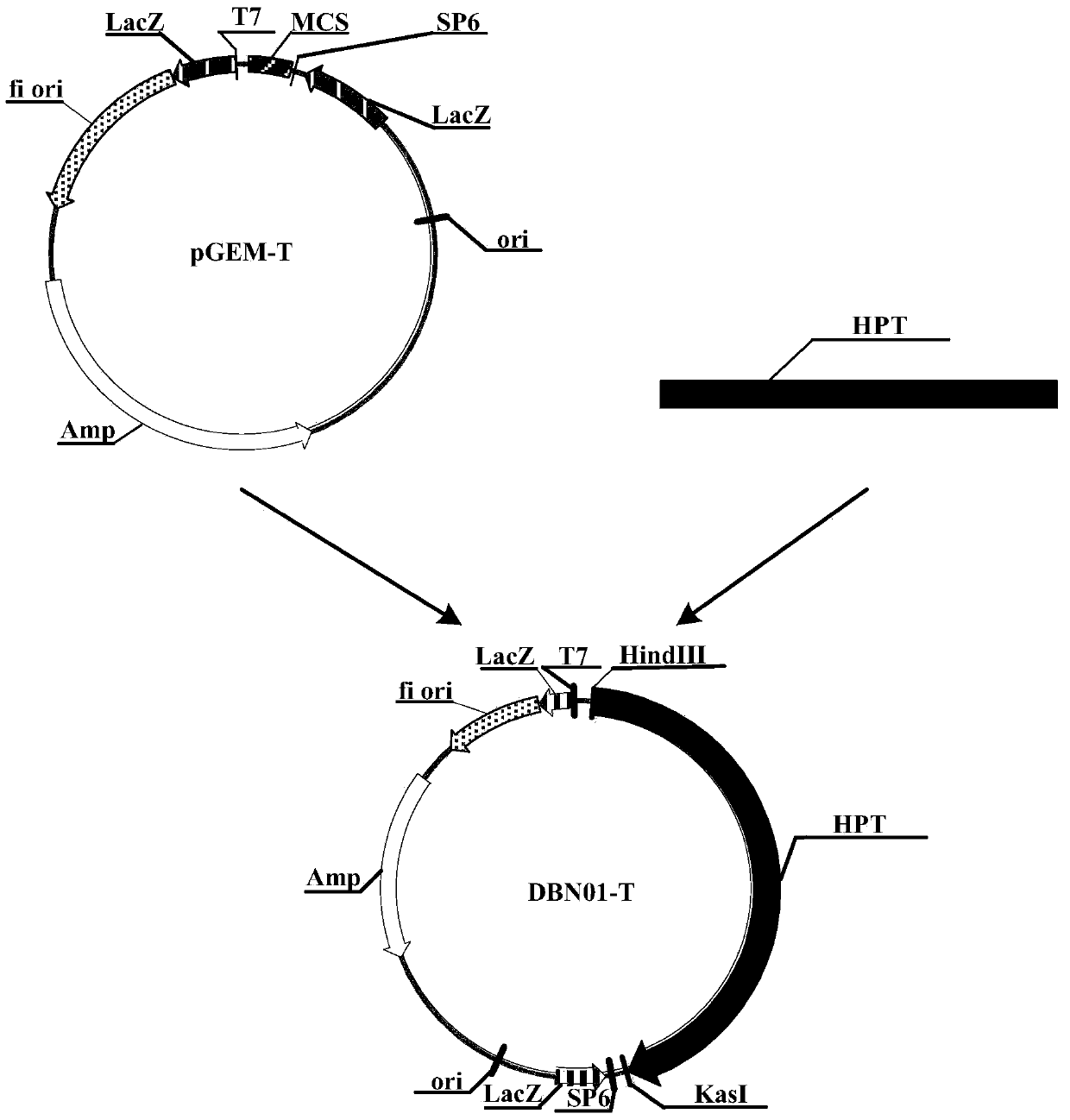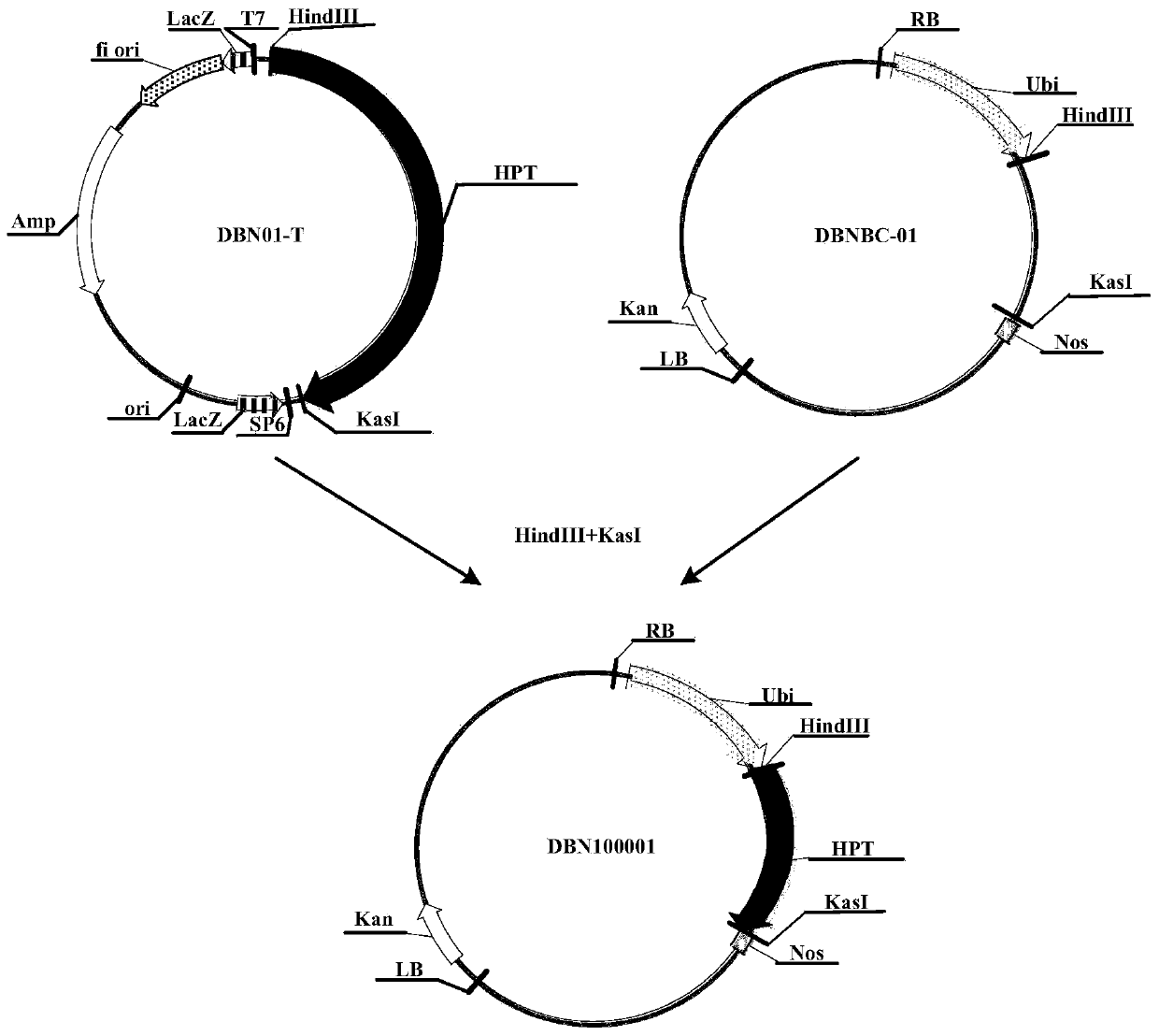Method for transforming rice
A rice and rice seed technology, applied in biochemical equipment and methods, horticultural methods, botanical equipment and methods, etc., can solve the problems of large demand for explants, strong genotype dependence, limited receptor materials, etc. Achieve the effect of reducing time and manpower consumption, reducing dependence and high conversion efficiency
- Summary
- Abstract
- Description
- Claims
- Application Information
AI Technical Summary
Problems solved by technology
Method used
Image
Examples
no. 1 example
[0051] The first embodiment, construction of recombinant expression vector and transformation of recombinant expression vector into Agrobacterium
[0052] 1. Construct a recombinant cloning vector containing the target gene
[0053]The HPT nucleotide sequence was connected to the cloning vector pGEM-T (Promega, Madison, USA, CAT: A3600), and the operation steps were carried out according to the instructions of the pGEM-T vector produced by Promega Company to obtain the recombinant cloning vector DBN01-T, and its construction process Such as figure 1 Shown (wherein, Amp represents the ampicillin resistance gene; f1 represents the replication origin of phage f1; LacZ is the LacZ start codon; SP6 is the promoter of SP6 RNA polymerase; T7 is the promoter of T7 RNA polymerase; HPT is the promoter of hygromycin Phosphotransferase gene nucleotide sequence (SEQ ID NO: 1); MCS is a multiple cloning site).
[0054] Then, the recombinant cloning vector DBN01-T was transformed into Esch...
no. 2 example
[0061] The second embodiment, the acquisition of transgenic rice plants
[0062] Sterilization of mature seeds: Take a number of mature rice seeds (Minghui 63), select brown rice with plump grains and intact embryos after shelling, put them in a triangular flask, and sterilize them with 75% (v / v) alcohol for 1 minute to remove Impurities such as rice bran on the surface of brown rice should be filtered off, then add sodium hypochlorite (containing Tween 20 (1 drop / 30mL)) with a mass fraction of 50%, shake and shake continuously for 20-40 minutes, and rinse with sterile water for 4- 5 times to remove residual sodium hypochlorite.
[0063] Callus induction: the brown rice after the above treatment was slightly dried and then inoculated in callus induction medium (a large amount of salt in N6 medium, a small amount of salt in B5 medium, organic matter in B5 medium, 30 g / L sucrose, 500 mg / L casein, grain Aminoamide 500mg / L, proline 500mg / L, 2-morpholineethanesulfonic acid (MES) 5...
no. 3 example
[0073] The third embodiment, using TaqMan to verify transgenic rice plants
[0074] About 100mg of the leaves of transgenic rice plants were taken as a sample, and the genomic DNA was extracted with Qiagen's DNeasy Plant Maxi Kit, and the copy number of the HPT gene was detected by the Taqman probe fluorescent quantitative PCR method. At the same time, wild-type rice plants were used as a control, and the detection and analysis were carried out according to the above method. The experiment was repeated 3 times, and the average value was taken.
PUM
 Login to View More
Login to View More Abstract
Description
Claims
Application Information
 Login to View More
Login to View More - R&D
- Intellectual Property
- Life Sciences
- Materials
- Tech Scout
- Unparalleled Data Quality
- Higher Quality Content
- 60% Fewer Hallucinations
Browse by: Latest US Patents, China's latest patents, Technical Efficacy Thesaurus, Application Domain, Technology Topic, Popular Technical Reports.
© 2025 PatSnap. All rights reserved.Legal|Privacy policy|Modern Slavery Act Transparency Statement|Sitemap|About US| Contact US: help@patsnap.com



